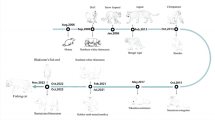Summary
In the mealy bug, Planococcus citri, following high dosage paternal irradiation (60,000–120,000 rep), the survivors are mostly female (about 30–40% of the unirradiated control value) whereas very few males survive (about 5% of control value). After lower doses of paternal irradiation (P. I.), however, few or no females survive while the normal number of males (never less than the control value) survive.
The females developing after high dosage P. I. are gynogenetic and are triploid or diploid or 3N/2N or 2N/N mosaics (Chandra 1963).
The cytology of X1 embryos following 90,000 rep is described in this report, in comparison with data from embryos following lower doses (8,000 r) of P. I. and unirradiated controls, to illustrate the chromosomal mechanisms leading to the production of gynogenetic females and the probable reasons for lethality of X1 males after heavy P. I.
It has been shown that triploid females stem from a fusion nucleus of the first and second polar bodies. This triploid polar nucleus, which normally participates in the formation of a polyploid sector in the young embryo, undertakes a successful embryogeny in many embryos when the zygote nucleus is unable to do so because of the heavily damaged paternal complement of chromosomes. Since the chromosomes are characterized by holokinetic activity, the irradiated paternal set manages to divide with the maternal complement but did not always segregate as successfully. Restitution divisions of the zygotic nuclei result in haploid, hyperhaploid, diploid and polyploid nuclei. Most of the diploid gynogenetic females probably originate from diploid nuclei of zygotic origin although it is possible that a few diploid females and the 2N/N mosaic females develop from polar bodies.
Similar content being viewed by others
References
Beatty, R. A.: Parthenogenesis and polyploidy in mammalian development. Cambridge: University Press 1957.
Bradley, M.: An aceto-carmine squash technic for mature embryo sacs. Stain Technol. 23, 29–40 (1948).
Briggs, R.: An analysis of the inactivation of the frog sperm nucleus by toluidine blue. J. gen. Physiol. 35, 761–780 (1952).
Brown, S. W.: Chromosome aberration in two aspidiotine species of the armored scale insects (Coccoidea-Diaspididae). Nucleus 8, 135–160 (1960).
—, and W. A. Nelson-Rees: Radiation analysis of a lecanoid genetic system. Genetics 46, 983–1007 (1961).
Chandra, H. S.: Inverse meiosis in triploid females of the mealy bug, Planococcus citri. Genetics 47, 1441–1454 (1962); - Cytogenetic studies following high dosage irradiation in the mealy bug, Planococcus citri. II. Cytology of X1 females and the problem of lecanoid sex determination. Chromosoma (Berl.) 14, 330–346 (1963).
Hertwig, O.: Die Radiumkrankheit tierischer Keimzellen. Arch. mikr. Anat. 77, 97–164 (1911).
Hughes-Schrader, S.: Cytology of coccids (Coccoidea-Homoptera). Advanc. Genet. 2, 127–203 (1948).
—, and H. Ris: The diffuse spindle attachment of coccids, verified by the mitotic behavior of induced chromosome fragments. J. exp. Zool. 87, 429–456 (1941).
McClintock, B.: The fusion of broken ends of sister half-chromatids following chromatid breakage at meiotic anaphases. Univ. Mo. Agr. Exp. Sta. Res. Bull. 290, 1–48 (1938).
Nelson-Rees, W. A.: A study of sex predetermination in the mealy bug, Planococcus citri (Risso). J. exp. Zool. 144, 111–137 (1960); - The effects of radiation damaged heterochromatic chromosomes on male fertility in the mealy bug Planococcus citri (Risso). Genetics 47, 661–683 (1962).
Rugh, R.: Developmental effects resulting from exposure to X-rays. I. Effect on the embryo of irradiation of frog sperm. Proc. Amer. phil. Soc. 83, 607–619 (1939).
Schrader, F.: The sex ratio and oogenesis of Pseudococcus citri. Z. indukt. Abstamm.-Vererb.-lehre 30, 163–182 (1923).
—, and S. Hughes-Schrader: Haploidy in metazoa. Quart. Rev. Biol. 6, 411–438 (1931).
Author information
Authors and Affiliations
Additional information
From a dissertation submitted to the University of California, in partial satisfaction of the requirements for the degree of Doctor of Philosophy.
Supported in part by a National Science Foundation Grant (No. G-9772) to Professor Spencer W. Brown.
N. I. H. Predoctoral Trainee in Genetics 1961–1962.
Rights and permissions
About this article
Cite this article
Chandra, H.S. Cytogenetic studies following high dosage paternal irradiation in the mealy bug, Planococcus citri. Chromosoma 14, 310–329 (1963). https://doi.org/10.1007/BF00326818
Received:
Issue Date:
DOI: https://doi.org/10.1007/BF00326818




